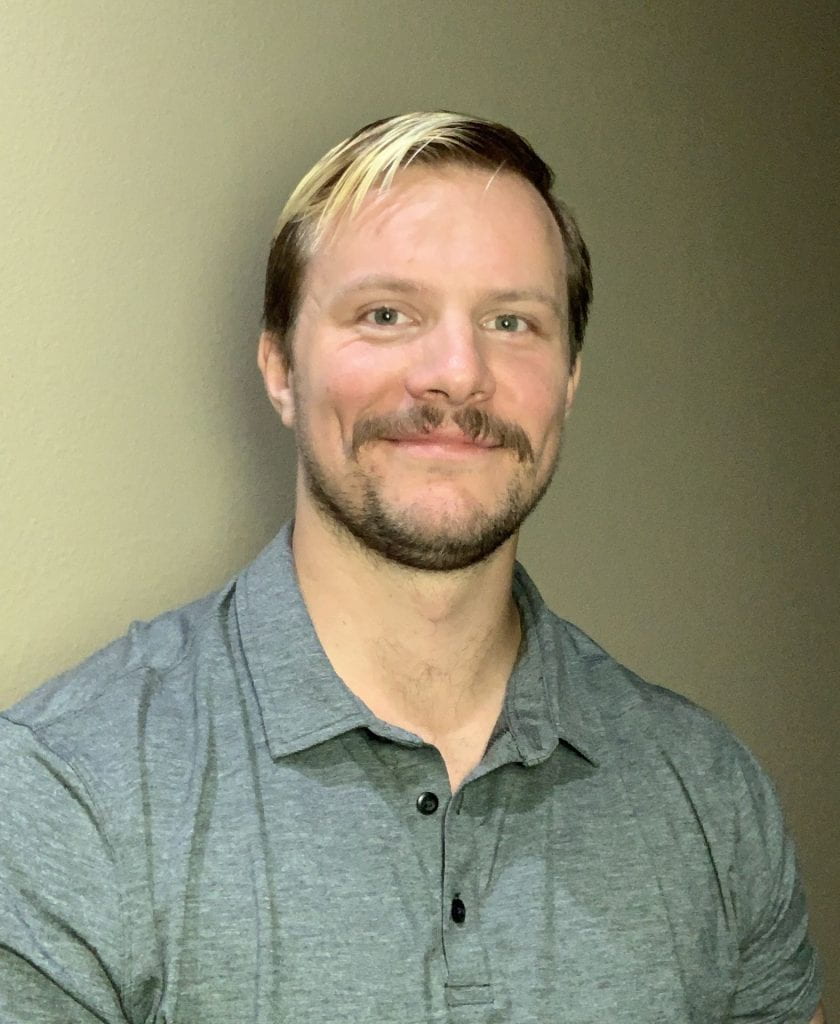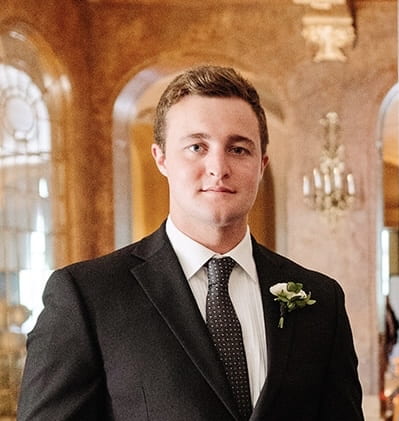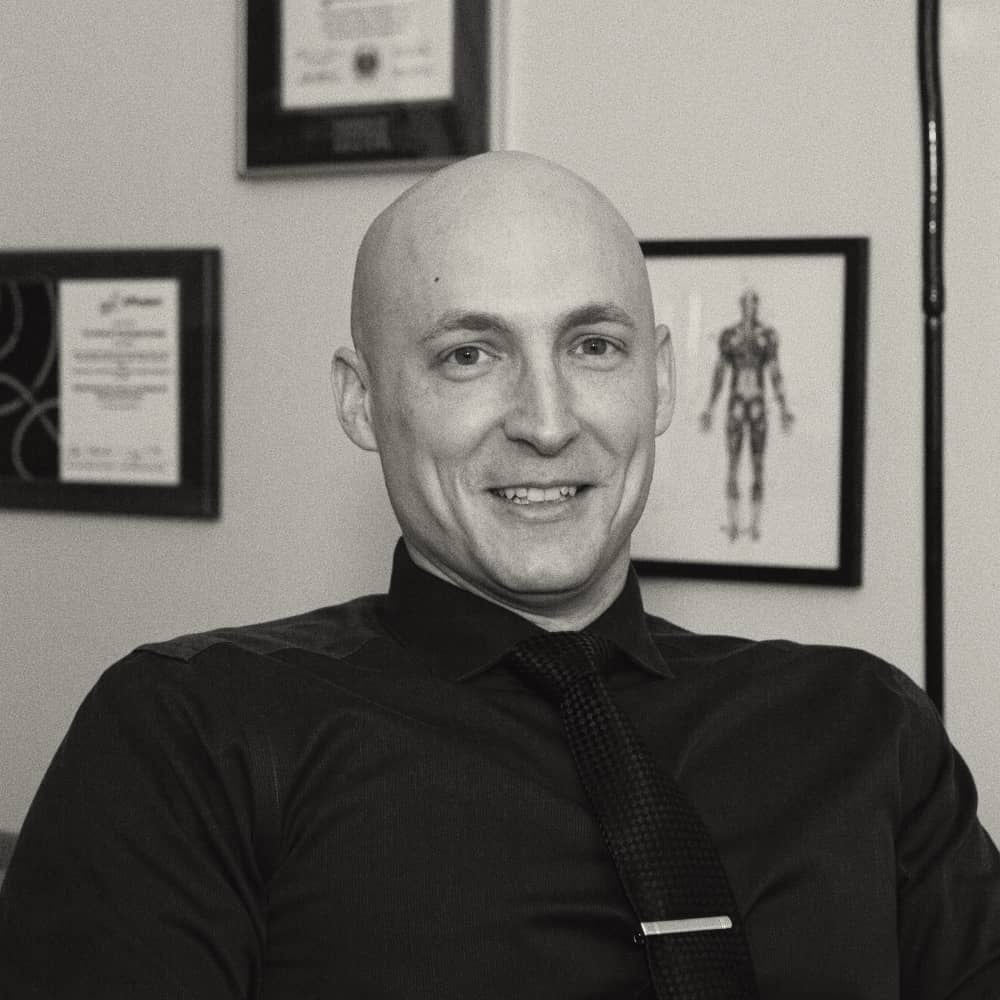Kevin A. Murach, Ph.D., received his undergraduate degree from the University of North Carolina at Chapel Hill, where he earned the Ronald Hyatt Scholarship in Exercise Science. After graduating, Dr. Murach completed a master’s degree in Exercise Physiology at James Madison University at Harrisonburg, Virginia, then earned his Ph.D. in Human Bioenergetics from the Ball State Human Performance Laboratory in Muncie, Indiana. His dissertation was a collaboration with NASA aimed at optimizing the exercise prescription for astronauts on the International Space Station.
After Ball State, Dr. Murach spent six years as a post-doctoral fellow/scholar at the University of Kentucky Center for Muscle Biology in Lexington under the guidance of Drs. Charlotte Peterson and John McCarthy. During this time, he was supported by two National Institutes of Health grants (F32 and K99), was recipient of the Thomas V. Getchell Memorial Award from the University of Kentucky Grant Writing Workshop, won the 2017 FASEB BioArt contest and was an NIH NIA Butler-Williams Scholar.
Articles featuring Dr. Murach:
- “UA researcher receives more funds from NIH for ongoing project” in The Arkansas Democrat Gazette
- “U of A Researcher Receives $713,000 Independent Scientist Award From NIH” in University of Arkansas News and University of Arkansas Research and Economic Development.
- “Aging Like An Olympian: The Exercises That Keep You Healthy And Independent” in Radio Health Journal
- “Researchers Across U of A Ranked Among Top in the World” in University of Arkansas News
- “Four Faculty Members Earn Global Recognition as Most-Cited Researchers” in WECARE Leading With Care Newsletter
- “College of Education and Health Professions Faculty Earn Global Recognition as Most-Cited Researchers” in The University of Arkansas News
- “Controlling a Cancer-Associated Gene Can Mimic Muscle Growth From Exercise” in The University of Arkansas News
- “After a break from strength training, muscle memory may help you bounce back” on National Public Radio – NPR
- “HEALTHIER LONGER: Two university researchers tackle the inevitable prospect of aging and how to be healthier longer” in University of Arkansas Determined
- “Department of Defense Funds Study of Gene Therapy for Muscular Degeneration” in The University of Arkansas News
- “Will Olympic athletes ever stop breaking records?” in Livescience.com
- “Murach Recognized With New Investigator Award From American Physiological Society” in The University of Arkansas News
- “NIH awards UA-Fayetteville $2.5M to study exercise, aging” in Arkansas Democrat Gazette
- “NIH Awards $2.5 Million to Study Mediators of Muscle Renewal as Aging Continues” in The University of Arkansas News
- “Why is it harder for some people to build muscle than others?” in Livescience.com
- “Study Reveals How Exercise Turns Back The Clock In Aging Muscles” in Medical News Today
- “How Even Super-Short Workouts Can Improve Your Health” in Time Magazine
- “How ‘Muscle Memory’ May Help Us Get In Shape” in The New York Times
- “Here’s what muscle memory really means, and how to use it” in The Washington Post
- “Weight Loss and Running Speed: How Exactly Are the Two Connected?” in Runner’s World
- “Why Less Exercise Can Bring Better Results” in Discover
- “How Scientists Are Learning How to Use Your Muscles to Predict Your Mortality” in Men’s Health
- “Snapshots of Life: Building Muscle in a Dish” in NIH Director’s Blog
- Research Spotlight of UK’s College of Health Sciences
- “Prior Training Can Accelerate Muscle Growth Even After Extended Idleness” in the University of Arkansas News
- “It’s never too late to start moving, but science is finding you may not catch up to lifelong exercisers” in the Philadelphia Inquirer
- “Late-Life Exercise Shows Rejuvenating Effects on Cellular Level” in the University of Arkansas News
He now is an associate professor in the Department of Health, Human Performance and Recreation in the University of Arkansas College of Education and Health Professions.
His current research uses human muscle samples, primary cell culture and genetically modified mouse models to understand the molecular cues that drive exercise adaptations and aging, and the interaction between these two (among other things). In his free time, Dr. Murach enjoys spending time with his wife, Dr. Kyndal Murach, exercising, building custom watches, cooking, smoking meats and collecting bourbon.

PJ Koopmans is a doctoral student in the M3R and was born and raised not too far from Madison, WI. He received his bachelor’s degree in Exercise and Sport Science from University of Wisconsin- La Crosse. More recently, he graduated with his master’s degree in Exercise Science from Appalachian State University under the mentorship of Dr. Kevin Zwetsloot in his Integrated Muscle Physiology Lab and was nominated as the departmental Outstanding Graduate Student in Research. His master’s thesis project was titled “Stuart Little No More: Effect of High Resistance Wheel Running on Skeletal Muscle Hypertrophy and Strength in C57BL/6 Mice”. TL;DR: mice love running and this voluntary behavior can be leveraged to serve as an exercise training model for mice. He is currently pursuing a Ph.D. in Cellular and Molecular Biology here at the University of Arkansas, where he is working as a graduate research fellow in Dr. Kevin Murach’s M3R Lab investigating the molecular/cellular mechanisms that regulate muscle mass and exercise adaptations. In his time outside of the lab and classroom, he trains for competitive powerlifting and is always on the hunt for the best pizza, donuts, and tacos (basically any food) in town.

Ronald G. Jones III is a doctoral student working in the M3R. Ronald received his undergraduate degree in Exercise Science from Towson University in Baltimore, Maryland. He then went on to complete a master’s degree in Clinical Exercise Physiology at the University of Delaware. Following graduation, he became accredited as a Certified Clinical Exercise Physiologist under the American College of Sports Medicine and was hired by the Baltimore VA Medical Center as a Research Physiologist. Over the next two years, he went on to become a Clinical Study Coordinator for numerous biomedical research studies, studying a host of topics such as peripheral arterial disease, post-stroke hypertrophy, clinical balance-reach trials, neuromuscular stimulation, and sarcopenia.
Wanting to continue a career in research, Ronald is now pursuing his PhD in the Department of Health, Human Performance, and Recreation in the University of Arkansas College of Education and Health Professions. His research focus includes the molecular and cellular mechanisms of skeletal muscle physiology and has a particular interest in genomics. Some of Ronald’s interests include building and repairing computers, reading, cooking, and training in both powerlifting and MMA (Mixed Martial Arts).
An article about Ron’s work: “Controlling a Cancer-Associated Gene Can Mimic Muscle Growth From Exercise” in The University of Arkansas News Now

Aram Parhizkar is a doctoral student in the M3R and was born and raised in Iran, where she also earned her bachelor’s degree in Cellular and Molecular Biology from the University of Tabriz, Iran. Her bachelor’s final project was titled “Different Types of RNA Molecules and their Role in Cancer Development” which was a literature review thesis focused on non-coding RNAs, particularly Long non- coding RNAs (lncRNAs) and, MicroRNAs (miRNAs), and their roles in cancer development, with emphasis on colorectal cancers. Following this, she moved to Italy to complete a master’s degree in Pharmaceutical Biotechnologies from the University of Padova, Italy where she ranked 3rd among the applicants admitted to the program. During her summer internship and master’s thesis, she worked on a project titled “Evaluation of Novel Inhibitors Targeting SARS-CoV-2 Main Protease; Towards Effective Antiviral Drug Discovery” under the supervision of Professor Barbara Gatto. This research had the aim of the identification of hit compounds capable of disrupting viral replication. She gained experience in Structure- Activity Relationship (SAR) studies, Fluorescence Resonance Energy Transfer (FRET)- based enzyme activity assays and mass spectrometry studies on this protease and its potential inhibitors. She has always been interested in studying molecular interactions and genetic studies and this passion led her to narrow her interest more specified on skeletal muscle and start her PhD studies under the supervision of Dr. Kevin Murach in the M3R lab at the University of Arkansas, studying cellular and molecular biology mechanisms behind muscle mass regulation and adaptation. In her free time, Aram enjoys traveling, trying new food, cooking, and solving puzzles or mysteries that challenge her.

Toby L. Chambers, Ph.D., received his undergraduate and master’s degrees in exercise science and exercise physiology from the University of Central Missouri in Warrensburg, Missouri. He then went on to earn a Ph.D. in Human Bioenergetics from the Ball State University Human Performance Laboratory in Muncie, Indiana. His doctoral work focused on the tissue (blood, skeletal muscle, and fat) responses in humans to an acute bout of resistance exercise and their implications for health and disease. After his doctoral work, Dr. Chambers aided in the implementation of the Molecular Transducers of Physical Activity Consortium (MoTrPAC) initiative established by the NIH’s Common Fund that includes 30+ academic institutions across the United States. The goals of MoTrPAC are to collect various tissue samples from both animal and human (adolescent and adult) subjects to build a “molecular map” of exercise responses and adaptations using various -omics platforms to better understand how physical activity benefits health and disease risks.
Wanting to further his knowledge and skillset in exercise and animal research, Dr. Chambers is now continuing his post-doctoral work with Dr. Kevin Murach in the Department of Health, Human Performance and Recreation in the University of Arkansas College of Education and Health Professions. His research will focus on the molecular mechanisms controlling skeletal muscle mass with aging and exercise training. Dr. Chambers is originally from the Kansas City, Missouri area and in his free time enjoys smoking meats, playing with his dog Cooper, exercising, reading, and eating new foods.

Regina Cabrera, PhD., is originally from Guatemala and holds a degree in Medical Laboratory Science (Química Bióloga) from the Universidad de San Carlos de Guatemala (USAC). She completed a postgraduate specialization in Molecular Biology and Genetics before pursuing graduate studies in the United States as a Fulbright-LASPAU scholar. Dr. Cabrera earned her M.S. in Cellular and Molecular Biology from the University of Arkansas, where she trained in both the Laboratory of Cellular Energetics and Mitochondrial Disorders and the Cachexia Research Lab. She continued her doctoral work in the Cachexia Research Lab with Dr. Nicholas Greene at the University of Arkansas, earning a Ph.D. in Health, Sport and Exercise Science. Her research has contributed to the understanding of the biology of skeletal muscle in the context of cancer cachexia, with particular attention to biological sex differences in muscle wasting during disease progression. Throughout her doctoral studies, she developed expertise in cell culture and mouse models, while also gaining early experience in bioinformatics. In 2025, Dr. Cabrera joined the M3R Lab as a postdoctoral scholar to expand her understanding of skeletal muscle biology beyond atrophy and into broader aspects of muscle plasticity. She is particularly interested in gaining hands-on experience with cutting-edge technologies to study how muscle adapts to exercise, aging, and various physiological or pathological conditions. Outside the lab, Dr. Cabrera enjoys traveling, biking on the Fayetteville trails, playing soccer, and reading Tolkien’s works — aspiring to become an expert in Middle-earth lore.

Nathan Serrano, Ph.D., is from Santa Ana, California where he participated in sports and physical activities throughout his K-12 and beyond driving his passion for Exercise Science. He joined Orange Coast College in California where he received his associate’s degree while competing as a Track and Field athlete. He took his athletic career to Boise State University as a Polevaulter while earning his bachelor’s degree in Exercise Science. While finishing his career in Track and Field, he began competing in the sport of Weightlifting while beginning a career in strength and conditioning. He moved back home where he worked as a strength and conditioning coach while earning his master’s degree at California State University, Fullerton. He published his work characterizing the muscle fiber phenotype of elite American weightlifters. He then earned his Ph.D. in Bioenergy with an emphasis in muscle fiber type expression from Arizona State University before joining Dr. Murach in the M3R Lab as a post-doctoral scholar. Dr. Serrano has significantly contributed to the understanding of muscle fiber phenotypes, particularly in contexts of obesity, and elite athletic performance. His notable studies include investigations into muscle fiber type distributions in elite weightlifters and the metabolic implications of muscle fiber types in individuals with obesity. His doctoral works investigated the muscle fiber type distribution of females with obesity where he found differences in skeletal muscle fiber types compared to lean females which were partially related to the obese pathology (i.e., body fat, insulin status, fitness, and physical activity), as well as genetic contributors (i.e., mRNA and small molecule RNA called microRNA). His research interests include understanding the genetic and epigenetic networks that govern the expression of muscle morphology and function.
